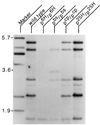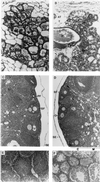A very large protein with diverse functional motifs is deficient in rjs (runty, jerky, sterile) mice
- PMID: 9689098
- PMCID: PMC21356
- DOI: 10.1073/pnas.95.16.9436
A very large protein with diverse functional motifs is deficient in rjs (runty, jerky, sterile) mice
Abstract
Three radiation-induced alleles of the mouse p locus, p6H, p25H, and pbs, cause defects in growth, coordination, fertility, and maternal behavior in addition to p gene-related hypopigmentation. These alleles are associated with disruption of the p gene plus an adjacent gene involved in the disorders listed. We have identified this adjacent gene, previously named rjs (runty jerky sterile), by positional cloning. The rjs cDNA is very large, covering 15,264 nucleotides. The predicted rjs-encoded protein (4,836 amino acids) contains several sequence motifs, including three RCC1 repeats, a structural motif in common with cytochrome b5, and a HECT domain in common with E6-AP ubiquitin ligase. On the basis of sequence homology and conserved synteny, the rjs gene is the single mouse homolog of a previously described five- or six-member human gene family. This family is represented by at least two genes, HSC7541 and KIAA0393, from human chromosome 15q11-q13. HSC7541 and KIAA0393 lie close to, or within, a region commonly deleted in most Prader-Willi syndrome patients. Previous work has suggested that the multiple phenotypes in rjs mice might be due to a common neuroendocrine defect. In addition to this proposed mode of action, alternative functions of the rjs gene are evaluated in light of its known protein homologies.
Figures






References
Publication types
MeSH terms
Substances
Associated data
- Actions
- Actions
- Actions
- Actions
Grants and funding
LinkOut - more resources
Full Text Sources
Molecular Biology Databases

